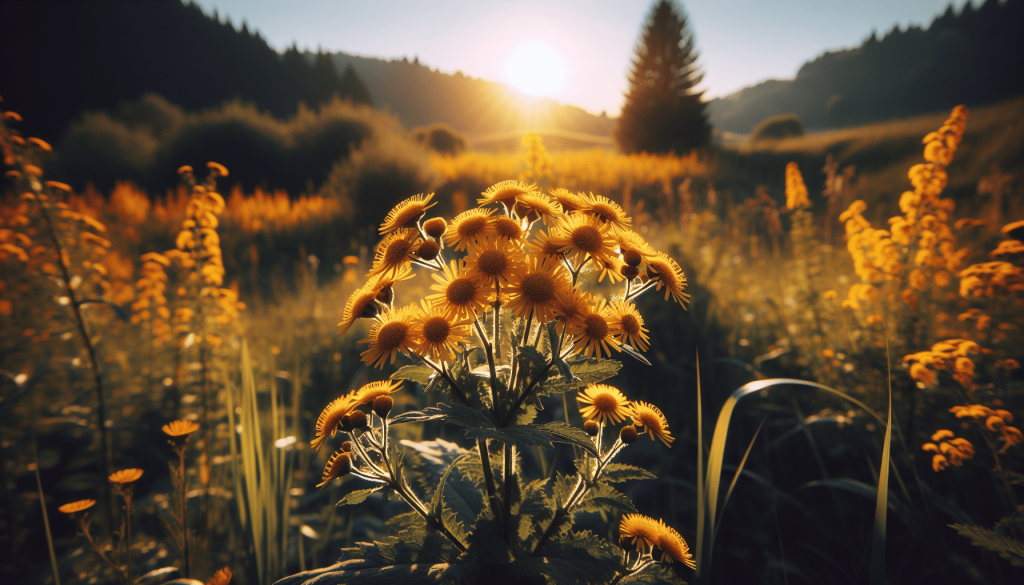This post may contain affiliate links. As an Amazon Associate, we may earn commissions from qualifying purchases.
Have you ever walked through a British field and stopped to appreciate the variety of plants blooming around you? One such plant that might have caught your eye, perhaps for its vibrant yellow flowers, is Ragwort. A plant native to Europe, Ragwort (Senecio jacobaea) has a notorious reputation, especially in the United Kingdom, where it is both a subject of controversy and admiration.
Understanding Ragwort (Senecio Jacobaea)
One of the first things to know about Ragwort is that it is a biennial plant, meaning it completes its life cycle in two years. In the first year, it forms a rosette of leaves close to the ground. By the second year, it sends up flowering stems that can reach anywhere from 30 cm to 1 meter in height. Its bright yellow flowers are often seen from June to November.
Scientific Classification
Here’s a brief look at its scientific classification to understand more about its place in the plant kingdom:
| Category | Description |
|---|---|
| Kingdom | Plantae |
| Order | Asterales |
| Family | Asteraceae |
| Genus | Senecio |
| Species | S. jacobaea |
Understanding its classification can help you in identifying Ragwort in the field, but knowing its place in the ecosystem is equally crucial.
Habitat and Distribution
Ragwort thrives in a variety of habitats. You’ll often find it in grasslands, meadows, waste grounds, and along roadways. It’s adaptable and hardy, making it a common sight across the UK. This adaptability is part of why it’s so widespread and sometimes considered invasive.
Ecological Importance of Ragwort
Now, here’s where things get interesting. Despite its bad reputation, Ragwort plays a significant role in the ecosystem.
Supporting Biodiversity
Ragwort is a food source for over 200 species of insects. How incredible is that? It’s particularly vital for the cinnabar moth (Tyria jacobaeae), whose larvae feed exclusively on Ragwort. Additionally, various bees, butterflies, and other pollinators are attracted to its bright flowers.
Soil Fertility
Interestingly, Ragwort also contributes to soil health. It’s known to thrive in poor, disturbed soils, and its presence can actually improve soil fertility over time. As it decomposes, it adds organic matter to the soil, enhancing its structure and nutrient content.

The Risks Associated with Ragwort
While Ragwort has its advantages, it’s crucial to acknowledge its potential hazards. This is especially true for livestock and humans.
Toxicity to Livestock
Ragwort contains pyrrolizidine alkaloids (PAs), which are toxic to liver cells in animals. Horses, cattle, and sheep are particularly vulnerable. When ingested in significant amounts, these toxins can cause severe liver damage and even death.
How Poisoning Occurs
Poisoning usually occurs when animals consume large amounts of Ragwort over a short period or smaller amounts over an extended period. It’s worth noting that the plant retains its toxicity even when dried in hay, making it a silent threat.
Effects on Humans
Though humans are less likely to ingest Ragwort, direct contact can cause skin irritation in sensitive individuals. There’s also a theoretical risk of long-term liver damage if Ragwort-contaminated herbal preparations are consumed.
Managing Ragwort
Given its dual nature as a beneficial and toxic plant, how should you manage Ragwort?
Identification and Monitoring
The first step in managing Ragwort is accurate identification. Look for basal rosettes in the first year and tall, yellow-flowered stalks in the second year. Regular monitoring of fields, particularly ones grazed by livestock, is essential.
Removal Techniques
Several methods can be employed to control Ragwort:
- Manual Removal: Uproot the plants by hand, ensuring you remove the entire root to prevent regrowth.
- Mechanical Control: Mowing can be effective but should be done before the plant flowers to prevent seed dispersal.
- Chemical Control: Herbicides can be useful but should be applied cautiously to avoid harming non-target species.
Safe Disposal
Once removed, Ragwort should be disposed of carefully. Composting is not advised because the toxins can persist. Instead, consider burning or disposing of it at designated facilities.

Legal Implications
In the UK, Ragwort is regulated under the Weeds Act 1959 and the Ragwort Control Act 2003. These laws aim to control the spread of Ragwort, particularly in areas where it poses a risk to grazing animals.
Landowner Responsibilities
As a landowner, you are legally required to manage Ragwort on your property. Failure to do so can result in enforcement action from authorities.
Reporting and Advice
If you encounter large infestations of Ragwort, it’s advisable to report them to your local council or the Department for Environment, Food & Rural Affairs (DEFRA). They can offer guidance and support for control measures.
Benefits of a Balanced Approach
While it’s essential to control Ragwort in areas where it poses a risk to livestock, it’s equally important to recognize its ecological value. An informed, balanced approach can help you manage this plant responsibly.
Promoting Biodiversity
By allowing Ragwort to grow in non-grazing areas, you can support insect populations and biodiversity. Creating designated Ragwort zones can be an effective strategy.
Rehabilitating Degraded Lands
You can also use Ragwort’s soil-improving properties to rehabilitate degraded lands. Its presence can prepare the soil for more desirable plant species in the future.
Frequently Asked Questions
To wrap up, let’s address some common questions about Ragwort.
Is Ragwort Dangerous to Dogs and Cats?
Yes, Ragwort can be harmful to dogs and cats if ingested. However, incidents are rare because these animals typically avoid the plant.
Can Ragwort Poison the Soil?
No, Ragwort does not poison the soil. Its toxins are specific to certain biological organisms and do not persist in the soil environment.
Is There a Safe Time to Allow Livestock to Graze on Fields with Ragwort?
To ensure safety, it’s best to keep livestock away from fields with Ragwort, especially during the flowering and seed-setting stages. If Ragwort is present, it should be controlled and removed before allowing animals to graze.
Final Thoughts
Respecting Ragwort means acknowledging both its dangers and its benefits. By understanding its role in the ecosystem and implementing responsible management practices, you can coexist with this fascinating plant in a way that protects both biodiversity and agricultural interests. Whether you’re a farmer, a gardener, or simply a nature enthusiast, there’s value in gaining a deeper appreciation for Ragwort and its place in the natural world.








